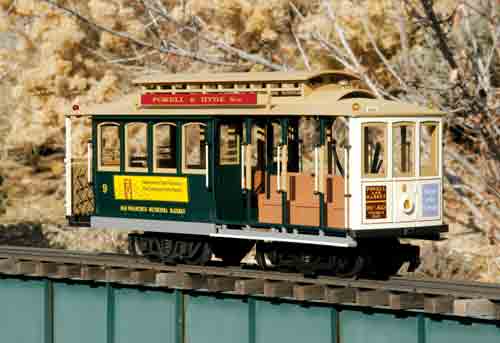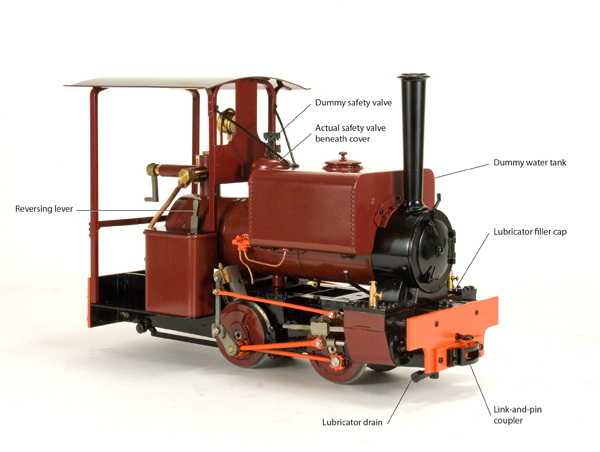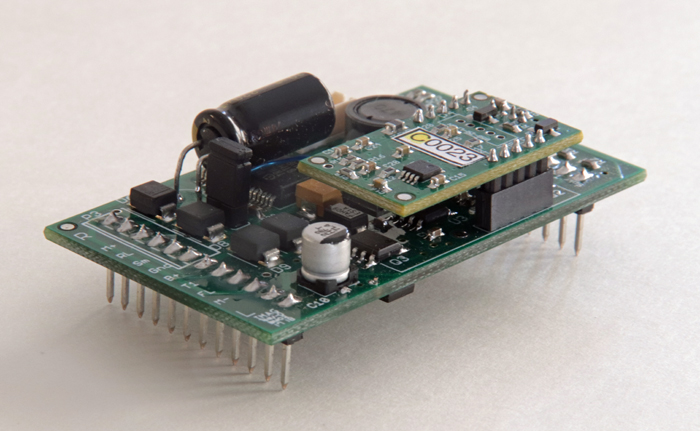1:24 scale, gauge-1 San Francisco cable car
AMS
33268 Central Avenue
Union City CA 94587
Price: $299 + s&h
Web site: www.amstrains.com
Plastic, ready-to-run model of a Powell & Hyde Streets cable car; interior detail; one power truck; working headlight and marker lights; available in two color schemes; two car numbers per color available. Dimensions: Length, 151/4 “; width, 41/8″; height, 7”. In 1:24 scale, this works out to 30’6″ x 8’3″ x 14’0″, respectively
Pros: Interesting model of an unusual prototype; captures the character of the prototype; correct scale-gauge combination; good paint and graphics; good operating characteristics; constant-intensity lights
Cons: Relatively low level of detail; some details “clunky” and ill defined; model has solid wheels where prototype has spoked; truck sideframes somewhat coarsely rendered; will not negotiate steep grades
Cable cars are not self powered. They rely on a constantly moving cable beneath the surface of the street, which they alternately grip and release to move along. Powell Street Nº 9, which our review sample represents, is a 3’6″-gauge “combination” car (having both inside and outside seating) built by the San Francisco Municipal Railway. It entered service in 2002.
The model is made primarily of plastic. Both side windows and clerestory windows are glazed. Handrails and the non-working folding gates at one end are metal. Our review sample is dark green and cream with a brown roof and black underbody (a maroon version is also available). The model features working marker lights on the four corners of the roof, tail lights beneath the floor at the rear, and headlight. There is a constant-intensity circuit (lights come on a little after the car starts to move). Graphics are crisp and clear and the paintwork is good.
Details on the model are fairly rudimentary. Many are coarsely rendered, such as the truck sideframes and the gripman’s control levers. The prototype has spoked wheels, whereas those on the model are solid. This criticism aside, the flavor of the San Francisco cable car is clearly captured in this well-proportioned model. The dimensions are close to the full-size car, though it stands a little tall.
Operating characteristics are generally good. The car starts at a crawl and runs smoothly and quietly. Except for starting and stopping, a full-size cable car tends to run at a constant speed, determined by the speed of the cable beneath. The Powell Street line’s cable runs at 91/2 miles per hour. Our review sample reached that speed at about 8 volts. At 24 volts, the scale speed was around 35 mph-too fast for a cable car but not unreasonable for other types of street railways. San Francisco cable cars have to negotiate grades of up to 21%. Ironically, our review sample had trouble with anything over about 4%. Traction tires would help.
This is an interesting model of an unusual prototype. There are examples of full-size cable-car bodies being motorized, so a self-powered car is not without precedent. Two or three of these cars would make a good, working municipal railway in the garden.














